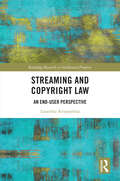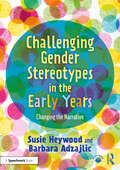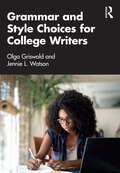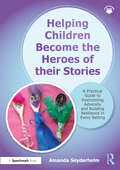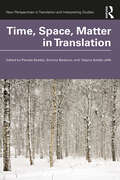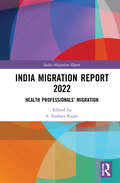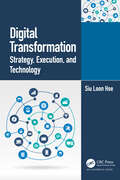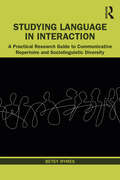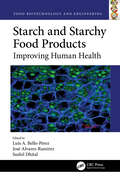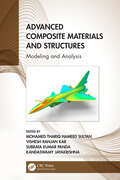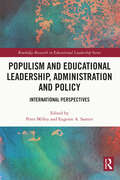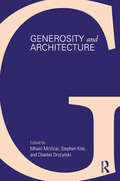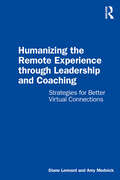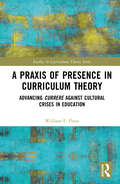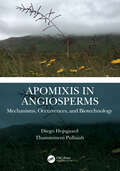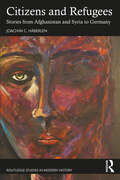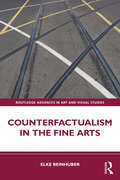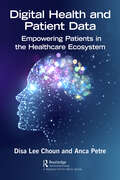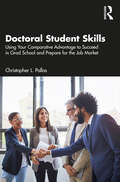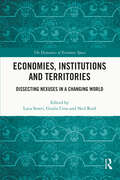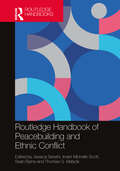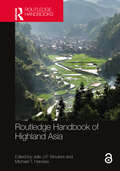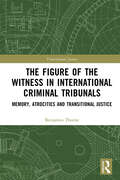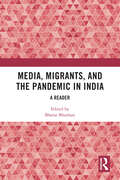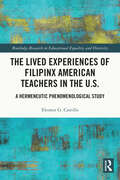Special Collections
Benetech’s Global Certified Accessible Titles
Description: Benetech’s GCA program is the first independent third-party EPUB certification to verify ebook accessibility. By creating content that is born accessible, publishers can meet the needs of all readers. Learn more: https://bornaccessible.benetech.org/
- Table View
- List View
Streaming and Copyright Law
by Lasantha AriyarathnaThis book examines the challenges posed to Australian copyright law by streaming, from the end-user perspective. It compares the Australian position with the European Union and United States to draw lessons from them, regarding how they have dealt with streaming and copyright. By critically examining the technological functionality of streaming and the failure of copyright enforcement against the masses, it argues for strengthening end-user rights. The rising popularity of streaming has resulted in a revolutionary change to how digital content, such as sound recordings, cinematographic films, and radio and television broadcasts, is used on the internet. Superseding the conventional method of downloading, using streaming to access digital content has challenged copyright law, because it is not clear whether end-user acts of streaming constitute copyright infringement. These prevailing grey areas between copyright and streaming often make end-users feel doubtful about accessing digital content through streaming. It is uncertain whether exercising the right of reproduction is appropriately suited for streaming, given the ambiguities of "embodiment" and scope of "substantial part". Conversely, the fair dealing defence in Australia cannot be used aptly to defend end-users’ acts of streaming digital content, because end-users who use streaming to access digital content can rarely rely on the defence of fair dealing for the purposes of criticism or review, news reporting, parody or satire, or research or study. When considering a temporary copy exception, end-users are at risk of being held liable for infringement when using streaming to access a website that contains infringing digital content, even if they lack any knowledge about the content’s infringing nature. Moreover, the grey areas in circumventing geo-blocking have made end-users hesitant to access websites through streaming because it not clear whether technological protection measures apply to geo-blocking. End-users have a severe lack of knowledge about whether they can use circumvention methods, such as virtual private networks, to access streaming websites without being held liable for copyright infringement. Despite the intricacies between copyright and access to digital content, the recently implemented website-blocking laws have emboldened copyright owners while suppressing end-users’ access to digital content. This is because the principles of proportionality and public interest have been given less attention when determining website-blocking injunctions.
Challenging Gender Stereotypes in the Early Years
by Susie Heywood and Barbara AdzajlicWhat does gender equity mean for early years practitioners? What are early years settings already doing to promote gender equality, and why is this so important? How can we provide children with a solid basis from which they can grow into people who are not limited by society’s expectations of their gender? This is a manual for every early years practitioner who wishes to expand their knowledge and improve their practice around gender stereotyping in the early years. Drawing from the authors’ experience developing a public health programme tackling gender stereotypes, it explores the reasons why gender inequality is still an issue, identifies the ways it is perpetuated and provides a framework and practical tools to drive change. The framework includes an audit process to celebrate areas of success and to identify areas for development, alongside a host of suggestions on how to navigate tricky situations in creative, respectful and effective ways. With the voices and experiences of experts and practitioners woven throughout, alongside key reflections and scenarios to critically engage with, Challenging Gender Stereotypes in the Early Years challenges readers to consider their own practice, drive staff awareness and make a difference to their setting.
Grammar and Style Choices for College Writers
by Olga Griswold and Jennie L WatsonThis textbook provides a practical guide to grammar and style choices for college writers, giving students a basic vocabulary for thinking and talking about language use and enabling them to make purposeful choices in their writing. Each section includes a short overview of a grammatical topic accompanied by exercises for raising the students’ awareness of and skills in using specific grammatical structures. It focuses on the practical and rhetorical functions of grammatical structures as they are used in expository and analytic writing, rather than on de-contextualized grammatical rules. Students will develop a repertoire of grammatical choices and understand the strategic reasons for making these choices in their writing for various audiences. It particularly attends to the structures that present the most difficulty for college students from multilingual communities and communities where a non-standard dialect of English is used on a daily basis. This textbook can be used as a core textbook for grammar course as well as a supplementary text for composition courses. It is also suitable for courses tailored to multilingual, advanced non-native, or non-standard speakers of English.
Helping Children Become the Heroes of their Stories
by Amanda SeyderhelmWhether it’s the anxiety of social isolation, the loss of routine or a breakdown in formal educational support, the COVID-19 pandemic has affected children in countless ways. Teachers, therapists and parents frequently find themselves ill-equipped to help children struggling with the difficult feelings that these situations, and others like them, give rise to. This essential guide provides a therapeutic toolkit to enable children to tell their stories and to regain some control over their mental health and wellbeing. The toolkit introduces a therapeutic story template, alongside guided support and examples focusing on three therapeutic skill sets: active listening, reflection and handling questions. Designed for use with children both individually and in class groups, the storytelling toolkit will enable children to see themselves as the hero of their own story, and life, and to reinstate a sense of optimism and self-empowerment in the face of the pandemic challenge. This resource provides a practical toolkit which can be used both inside and outside the classroom to help children to tell their lockdown stories. It will be valuable reading for teachers, SENCOs, therapists, mental health leads and parents.
Time, Space, Matter in Translation
by Simona Bertacco and Pamela Beattie and Tatjana Soldat-JaffeTime, Space, Matter in Translation considers time, space, and materiality as legitimate habitats of translation. By offering a linked series of interdisciplinary case studies that show translation in action beyond languages and texts, this book provides a capacious and innovative understanding of what translation is, what it does, how, and where. The volume uses translation as a means through which to interrogate processes of knowledge transfer and creation, interpretation and reading, communication and relationship building—but it does so in ways that refuse to privilege one discipline over another, denying any one of them an entitled perspective. The result is a book that is grounded in the disciplines of the authors and simultaneously groundbreaking in how its contributors incorporate translation studies into their work. This is key reading for students in comparative literature—and in the humanities at large—and for scholars interested in seeing how expanding intellectual conversations can develop beyond traditional questions and methods.
India Migration Report 2022
by S. Irudaya RajanIndia Migration Report 2022 is one of the first volumes to focus comprehensively on Indian health professionals’ migration. The essays in the volume discuss the reasons, challenges and opportunities that daunt and prompt health professionals to migrate within and outside India. This volume: • Explores the history of migration of health professionals, especially nurses from India; • Focuses in economic and social drivers of migration among health professionals; • Examines shifting patterns in migration as well as emergence of new destinations for migrants; • Studies the economic and social impact of COVID-19 among migrant health professionals; • Highlights the influence of remittances on rural economies in India. Timely, data-driven and drawing on exhaustive fieldwork, the volume looks at Indian health professionals in North America, Middle East, Asia Pacific and South Asia. It will be of interest to scholars and researchers of development studies, public health, public policy, economics, demography, sociology and social anthropology, and migration and diaspora studies.
Digital Transformation
by Siu Loon HoeDigital transformation is a multidimensional concept and involves many moving parts. Successful digital transformation requires a fresh approach to harnessing people, processes, technology, and data to develop new business models and digital ecosystems. One main barrier could be an overemphasis on applying technology to expand the business rather than transforming the people’s mindsets to do things differently. Thus, it is important to develop a holistic view of these parts and assemble them to foster the right conditions for digital transformation to happen. Business leaders and executives must be equipped with a wide range of digital competencies to thrive in a rapidly changing digital environment. Digital Transformation: Strategy, Execution, and Technology provides an overall view on the strategy, execution, and technology for organizations aiming to transform digitally. It offers insights on how to become more successful in the digital age by explaining the importance and relevance of the various building blocks which form the foundation of a digital organization. It shows the reader how to develop these building blocks in the organization as part of the digital transformation journey from both a business and technical perspective. Highlights of the book include: Digital transformation strategy Digital governance and risk management Digital organization and change management Experimental learning and design thinking Digital product management Agile and DevSecOps Digital enterprise architecture Business applications of digital technology This practical guide is written keeping business and information technology professionals and digital transformation practitioners in mind. It is also suitable for students pursuing postgraduate degrees and participants attending executive education programs in business and information technology.
Studying Language in Interaction
by Betsy RymesStudying Language in Interaction is a holistic practical guide with a hybrid purpose: To emphasize a particular approach to language in the world—a theory of language that has room for communicative repertoire and sociolinguistic diversity—and to provide a practical guide for new researchers of language in interaction. Each chapter focuses on one way of communicating, providing a set of strategies to observe, note, and reflect on context-specific ways of using multiple languages, of sounding, naming, using social media, telling stories, being ironic, and engaging in everyday routines. This approach provides a practical guide without stripping out all the wonder and nuance of language in interaction that originally draws the novice researcher to critical inquiry and makes language relevant to the humans who use it every day. Studying Language in Interaction is not only a practical research guide; it is also a workbook for being in the world in ways that matter, illustrating that any research on language in interaction involves both tricks of the trade and a sustained engagement with humanity. With extensive pedagogical resources, this is an ideal text for advanced undergraduate and graduate students of sociolinguistics, intercultural communication, linguistic anthropology, and education who are embarking on fieldwork projects.
Starch and Starchy Food Products
by Luis A. Bello-Pérez, José Alvarez-Ramírez, and Sushil DhitalStarch is one of the main staples in human food, its consumption having both positive and negative aspects. The exploration and exploitation of starches from alternative botanical sources has been increasing recently due to interest in the economic and social development of tropical and sub-tropical regional economies and in support of sustainability. The book reviews existing research on various aspects of starch, including physicochemical, nutritional and functional properties, plus applications in addition to foods. Emphasis is on the various physical and chemical modifications, which are aimed at improving the properties and applicability of starch. Key Features Analyzes the state of the art of the scientific and technological problems associated with starch Describes various applications of starch in foods Provides a broad view on the field of starch and starchy foods
Advanced Composite Materials and Structures
by Mohamed Thariq Hameed Sultan and Vishesh Ranjan Kar and Subrata Kumar Panda and Kandaswamy JayakrishnaThis book bridges the gap between the theoretical concepts and their implementations, especially for the high-performance structures/components related to advanced composite materials. It focusses on the prediction of various structural responses such as deformations, natural frequencies etc. of advanced composites under complex environments and/or loading conditions. In addition, it discusses micro-mechanical material modeling of various advanced composite materials including different structures ranging from basic to advanced, such as beam, flat and curved panel, shell, skewed, corrugated etc. and various solution techniques via analytical, semi-analytical and numerical approaches. Covers micro-mechanical material modeling of advanced composite materials Describes constitutive models of different composite materials and kinematic models of different structural configuration Discusses pertinent analytical, semi-analytical and numerical techniques Focusses on structural responses relating to deformations, natural frequencies, critical loads, under complex environments Presents actual demonstration of theoretical concepts applied to real examples using Ansys APDL scripts This book is aimed at researchers, professionals and graduate students in mechanical engineering, material science, material engineering, structural engineering, aerospace engineering, and composite materials.
Populism and Educational Leadership, Administration and Policy
by Eugenie A. Samier and Peter MilleyThis book explores the theoretical and practical implications of a global resurgence of populism on educational leadership. Drawing together a wide range of international authors, it examines how socio-cultural and political populist developments affect educational policies, organisations, and administration around the world. The collection addresses the forms and meanings of populism and examines their influence on education systems and institutions. It includes theoretical perspectives and rich examples from Australia, Brazil, Canada, Finland, France, Hungary, Nicaragua, the UK, and the US, exploring the complex influences and effects of populism on education policy, politics, and institutions in these countries. These include attacks on initiatives promoting equity and inclusion, the repression of academic freedom, the erosion of institutional autonomy from partisan political direction, and the suppression of evidence and expertise in policy and curriculum development. With its international and multidisciplinary outlook, this book will be highly relevant reading for researchers, scholars, and students in the fields of educational leadership and administration, higher education, and education policy, as well as those interested in the contemporary manifestations of populism on education.
Generosity and Architecture
by Mhairi McVicar, Stephen Kite, and Charles DrożyńskiThis book proposes that architecture can function as a true embodiment of generosity and examines how generosity in architecture operates within, and questions, current and historical socio-economic and political systems. As such, it interrogates ways in which architecture aspires for something more, whether within economic austerities or within historic contexts of a discipline that has often been preoccupied with cost and quantitative measurement. The texts presented in this book critically examine the theme of generosity and architecture from a variety of perspectives, addressing the theoretical, the historical, and the everyday processes of architectural practice, procurement, and policy in a global context. The book is a richly collaborative text which explores how architecture – in its processes of ordering and shaping space – can represent and embody generosity in all its multi-faceted potential.
Humanizing the Remote Experience through Leadership and Coaching
by Diane Lennard and Amy MednickThis book responds to the growing need for understanding how we can foster wellness, raise engagement, and strengthen connections in professional contexts as human interactions become increasingly remote. Through research and case studies, the authors outline a paradox: the digital technology we use to connect with others can leave us feeling less connected. To understand what is missing from remote interactions, the authors examine the use of space, sensory cues, group dynamics, and challenges people encounter when the innate need for human connection is unmet. They provide practical advice to improve remote experiences, including ways to manage stress, avoid cognitive overload, and prevent burnout. Ultimately, the book highlights what is possible when we focus not only on the quantity and efficiency of our interactions, but also on the quality and depth of our human connections. The contemporary relevance of this topic makes the book essential for leaders, coaches, consultants, and other professionals working remotely, as well as students and interested individuals seeking to improve their personal and professional remote experiences.
A Praxis of Presence in Curriculum Theory
by William F. PinarBuilding on his seminal methodological contribution to the field – currere – here William F. Pinar posits a praxis of presence as a unique form of individual engagement against current cultural crises in education. Bringing together a series of updated essays, articles, and new writings to form this comprehensive volume, Pinar first demonstrates how a praxis of presence furthers the study of curriculum as lived experience to overcome self-enclosure, restart lived and historical time, and understand technology through a process of regression, progression, analysis, and synthesis. Pinar then further illustrates how this practice can inform curricular responses to countering presentism, narcissism, and techno-utopianism in educators’ work with "digital natives." Ultimately, this book offers researchers, scholars, and teacher educators in the fields of curriculum theory, the sociology of education, and educational policy more broadly the analytical and methodological tools by which to advance their understanding of currere, and in doing so, allows them to tackle the main cultural issues that educators face today.
Apomixis in Angiosperms
by Thammineni Pullaiah and Diego HojsgaardApomixis is a difficult-to-analyse trait with a complex molecular basis and a substantive effect on the biology of a species. Thus, apomixis is an interesting characteristic for researchers and students working in different fields of plant science and agriculture, and technological advances are enabling and making apomixis studies more common. Apomixis in Angiosperms: Mechanisms, Occurrences, and Biotechnology provides a systematic introduction to the mechanisms and developmental types of apomixis along with an overview of alternative methodologies for identifying apomixis and a detailed reassessment of the occurrences of apomictic species among angiosperm families. Optional methods are illustrated with examples of all types of apomixis and biological levels of analysis, i.e. cells, ovules, seeds and offspring. Data on apomictic species are collected in tables along with information on ploidy, type of apomixis and references. Occurrences of apomixis are briefly discussed in phylogenetic and evolutionary contexts. An outline of the molecular basis of apomixis in plants is presented, together with prospects and challenges that remain for its biotechnological exploitation. This book: Provides a systematic overview of the mechanisms of apomixis, developmental types and methodology for apomixis research. Reassesses apomixis at the species level in angiosperm families. Contains tables summarizing relevant information on apomixis. Analyses occurrences of apomixis in phylogenetic and evolutionary contexts. Outlines the molecular basis and biotechnological perspective of apomixis breeding. This book presents an accessible overview of apomixis research and a curated dataset of apomictic species. It serves as a reference book for students, researchers and citizen scientists interested in apomixis, as well as researchers, business innovators and entrepreneurs pursuing apomixis breeding. It can also be used as a textbook in graduate courses on plant reproduction. Diego Hojsgaard Taxonomy and Evolutionary Biology, Leibniz Institute of Plant Genetics and Crop Plant Research, Gatersleben, Germany, and Faculty of Exact, Chemical and Natural Sciences, National University of Misiones, Posadas, Argentina. Thammineni Pullaiah Department of Botany, Sri Krishnadevaraya University, Anantapur, India.
Citizens and Refugees
by Joachim C. HäberlenFollowing the stories of two dozen refugees from Syria and Afghanistan in 2015, Citizens and Refugees argues that we need to include the histories of these countries, notably the Syrian Revolution, into narratives of the refugee crisis. The book thus challenges a framing of the crisis that usually begins only with the moment of people fleeing. The stories it tells show refugees as citizens with a political voice engaged in struggles for participation and democracy, rather than as people in need of rescuing and integrating into new societies. It equally examines the much-celebrated German welcoming culture of 2015, arguing that it silenced political voices of those fleeing to Germany. Based on personal stories and the author’s intimate knowledge of the German welcoming culture, Citizens and Refugees intervenes into political debates about the viability of democracy. Overall, the importance of this volume stems from its suggestion that we would do well to listen to the voice of those coming to Europe as refugees. Based on both personal stories and historical analysis, Citizens and Refugees is the ideal resource for upper-level undergraduates, postgraduates, and scholars interested in migration studies and the history of Europe and the Middle East.
Counterfactualism in the Fine Arts
by Elke ReinhuberCounterfactual thinking has become an established method to evaluate decisions in a range of disciplines, including history, psychology and literature. Elke Reinhuber argues it also has valuable applications in the fine arts and popular media. A fascination with the path not taken is a logical consequence of a world saturated with choices. Art which provokes and explores these tendencies can help to recognise and contextualise the impulse to avoid or endlessly revisit individual or collective decisions. Reinhuber describes the term in broad strokes through the disciplines to show how counterfactualism finds shape in contemporary art forms, especially in photography, film, and immersive and interactive media art (such as 360° content, virtual reality and augmented reality). She analyses the different stages of counterfactuals with examples where artists experience counterfactual thoughts in the process of art production, explore these thoughts in their artwork, and where the artwork itself evokes counterfactual thoughts in the audience. A fascinating exploration for scholars and students of art, media and the humanities, and anybody else with an interest in choices, the art of decisionmaking and counterfactualism.
Digital Health and Patient Data
by Disa Lee Choun and Anca PetrePatients with unmet needs will continue to increase as no viable nor adequate treatment exists. Meanwhile, healthcare systems are struggling to cope with the rise of patients with chronic diseases, the ageing population and the increasing cost of drugs. What if there is a faster and less expensive way to provide better care for patients using the right digital solutions and transforming the growing volumes of health data into insights? The increase of digital health has grown exponentially in the last few years. Why is there a slow uptake of these new digital solutions in the healthcare and pharmaceutical industries? One of the key reasons is that patients are often left out of the innovation process. Their data are used without their knowledge, solutions designed for them are developed without their input and healthcare professionals refuse their expertise. This book explores what it means to empower patients in a digital world and how this empowerment will bridge the gap between science, technology and patients. All these components need to co-exist to bring value not only to the patients themselves but to improve the healthcare ecosystem. Patients have taken matters into their own hands. Some are equipped with the latest wearables and applications, engaged in improving their health using data, empowered to make informed decisions and ultimately are experts in their disease(s). They are the e-patients. The other side of the spectrum are patients with minimal digital literacy but equally willing to donate their data for the purpose of research. Finding the right balance when using digital health solutions becomes as critical as the need to develop a disease-specific solution. For the first time, the authors look at healthcare and technologies through the lens of patients and physicians via surveys and interviews in order to understand their perspective on digital health, analyse the benefits for them, explore how they can actively engage in the innovation process, and identify the threats and opportunities the large volumes of data create by digitizing healthcare. Are patients truly ready to know everything about their health? What is the value of their data? How can other stakeholders join the patient empowerment movement? This unique perspective will help us re-design the future of healthcare - an industry in desperate need for a change.
Doctoral Student Skills
by Christopher L. PallasDoctoral Student Skills offers a comprehensive overview of the key skills doctoral students need to succeed in their studies and prepare for academic and non-academic jobs. Revealing the often-hidden rules of graduate school success, it guides students through challenges like selecting a research topic, choosing an advisor, preparing for conferences, publishing their work, and entering the job market. The book begins by explaining how to survey the job market and identify "signifiers" that will signal to future employers the student’s suitability for a job. It then guides students to reflect on their own experiences and abilities to identify their areas of comparative advantage. Providing detailed instructions on how to acquire key signifiers – including conference presentations, publications, grants, awards, and teaching experience – the volume prepares students for future professional success, while teaching them how to leverage these activities to enhance their progress in their present studies. The book is designed to be used as a course text or for self-study. Each chapter features reflective exercises that can be used individually or in small groups, along with recommended readings and additional resources to enhance student learning.
Economies, Institutions and Territories
by Neil Reid and Luca Storti and Giulia UrsoPresenting multidisciplinary and global insights, this book explores the nexus between economies, institutions, and territories and how global phenomena have local consequences. It examines how original and innovative economic related processes embed themselves in societies at the local level; how boundaries between the state and the market are placed under stress by unexpected changes. It explores whether new types of elites and forms of social inequalities are emerging as a result of institutional and economic changes, and whether peripheral areas are experiencing insidious forms of economic and institutional lock-in. Presenting empirical cases and useful analytical and conceptual tools, the book makes current economic and territorial phenomena more understandable. This is an important read for students and scholars in the fields of geography, sociology, political sciences, anthropology, economics, regional science, and international relations. It is also a valuable resource for policymakers, well-educated lay readers and economic, political and international relations journalists.
Routledge Handbook of Peacebuilding and Ethnic Conflict
by Sean Byrne and Imani Michelle Scott and Jessica Senehi and Thomas G. MatyókThis handbook offers a comprehensive analysis of peacebuilding in ethnic conflicts, with attention to theory, peacebuilder roles, making sense of the past and shaping the future, as well as case studies and approaches. Comprising 28 chapters that present key insights on peacebuilding in ethnic conflicts, the volume has implications for teaching and training, as well as for practice and policy. The handbook is divided into four thematic parts. Part 1 focuses on critical dimensions of ethnic conflicts, including root causes, gender, external involvements, emancipatory peacebuilding, hatred as a public health issue, environmental issues, American nationalism, and the impact of the COVID-19 pandemic. Part 2 focuses on peacebuilders’ roles, including Indigenous peacemaking, nonviolent accompaniment, peace leadership in the military, interreligious peacebuilders, local women, and young people. Part 3 addresses the past and shaping of the future, including a discussion of public memory, heritage rights and monuments, refugees, trauma and memory, aggregated trauma in the African-American community, exhumations after genocide, and a healing-centered approach to conflict. Part 4 presents case studies on Sri Lanka’s postwar reconciliation process, peacebuilding in Mindanao, the transformative peace negotiation in Aceh and Bougainville, external economic aid for peacebuilding in Northern Ireland, Indigenous and local peacemaking, and a continuum of peacebuilding focal points. The handbook offers perspectives on the breadth and significance of peacebuilding work in ethnic conflicts throughout the world. This volume will be of much interest to students of peacebuilding, ethnic conflict, security studies, and international relations.
Routledge Handbook of Highland Asia
by Jelle J.P. Wouters and Michael T. HeneiseThe Routledge Handbook of Highland Asia is the first comprehensive and critical overview of the ethnographic and anthropological work in Highland Asia over the past half a century. Opening up a grand new space for critical engagement, the handbook presents Highland Asia as a world-region that cuts across the traditional divides inherited from colonial and Cold War area divisions - the Indian Subcontinent/South Asia, Southeast Asia, China/East Asia, and Central Asia. Thirty-two chapters assess the history of research, identify ethnographic trends, and evaluate a range of analytical themes that developed in particular settings of Highland Asia. They cover varied landscapes and communities, from Kyrgyzstan to India, from Bhutan to Vietnam and bring local voices and narratives relating trade and tribute, ritual and resistance, pilgrimage and prophecy, modernity and marginalization, capital and cosmos to the fore. The handbook shows that for millennia, Highland Asians have connected far-flung regions through movements of peoples, goods and ideas, and at all times have been the enactors, repositories, and mediators of world-historical processes. Taken together, the contributors and chapters subvert dominant lowland narratives by privileging primarily highland vantages that reveal Highland Asia as an ecumune and prism that refracts and generates global history, social theory, and human imagination. In the currently unfolding Asian Century, this compels us to reorient and re-envision Highland Asia, in ethnography, in theory, and in the connections between this world-region, made of hills, highlands and mountains, and a planetary context. The handbook reveals both regional commonalities and diversities, generalities and specificities, and a broad orientation to key themes in the region. An indispensable reference work, this handbook fills a significant gap in the literature and will be of interest to academics, researchers and students interested in Highland Asia, Zomia Studies, Anthropology, Comparative Politics, Conceptual History and Sociology, Southeast Asian Studies, Central Asian Studies and South Asian Studies as well as Asian Studies in general.
The Figure of the Witness in International Criminal Tribunals
by Benjamin ThorneThis book analyses how international criminal institutions, and their actors – legal counsels, judges, investigators, registrars – construct witness identity and memory. Filling an important gap within transitional justice scholarship, this conceptually led and empirically grounded interdisciplinary study takes the International Criminal Tribunal for Rwanda (ICTR) as a case study. It asks: How do legal witnesses of human rights violations contribute to memory production in transitional post-conflict societies? Witnessing at tribunals entails individuals externalising memories of violations. This is commonly construed within the transitional justice legal scholarship as an opportunity for individuals to ensure their memories are entered into an historical record. Yet this predominant understanding of witness testimony fails to comprehend the nature of memory. Memory construction entails fragments of individual and collective memories within a contestable and contingent framing of the past. Accordingly, the book challenges the claim that international criminal courts and tribunals are able to produce a collective memory of atrocities; as it maintains that witnessing must be understood as a contingent and multi-layered discursive process. Contributing to the specific analysis of witnessing and memory, but also to the broader field of transitional justice, this book will appeal to scholars and practitioners in these areas, as well as others in legal theory, global criminology, memory studies, international relations, and international human rights.
Media, Migrants and the Pandemic in India
by Bharat BhushanThe national lockdown to contain the COVID-19 pandemic in India resulted in the loss of work and displacement of thousands of urban migrant workers. This book records the arduous journey home for many of these workers and analyses the grave effects the pandemic has had on jobs, livelihoods, and the health of urban migrant workers. A rich compilation of deep analytical articles by journalists, academics, lawyers, and social activists, this book explores various facets of the crisis as it unfolded. It examines the welfare policies of state and central governments and discusses the role of the judiciary and the public policy response to the unemployment, health risks, and mass migration of workers. It also offers readers a better understanding of the complexities of the migrant crisis, how it unfolded, and how it was addressed by the media. This timely and prescient book will be of great interest to the general reader as well as researchers and students of media studies, journalism, sociology, law, public policy, labour and economics, welfare economics, gender studies, and development studies.
The Lived Experiences of Filipinx American Teachers in the U.S.
by Eleonor G. CastilloThis text offers a hermeneutic phenomenological exploration of the lived experiences of Filipinx American teachers in U.S. schools, classrooms, and colleges. By drawing on one-on-one dialogues, group discussion, and reflective writing, the text identifies racial, cultural, and linguistic barriers that members of this minority group have faced in their training and practice as educators. The text questions the underrepresentation of Filipinx Americans amongst U.S. teaching staff, and identifies causes both within the Filipino community, and via external factors, including the absence of Filipino culture in curricula, as well as a lack of peer support in the development of Asian American teacher identities. This timely volume highlights the need to expand diversity teacher education to create a more racially diverse and inclusive workforce. Offering rich insight into the experiences of Filipinx American teachers, this volume will be of interest to students, scholars and researchers drawn to studies of multicultural education, as well as teacher education.
